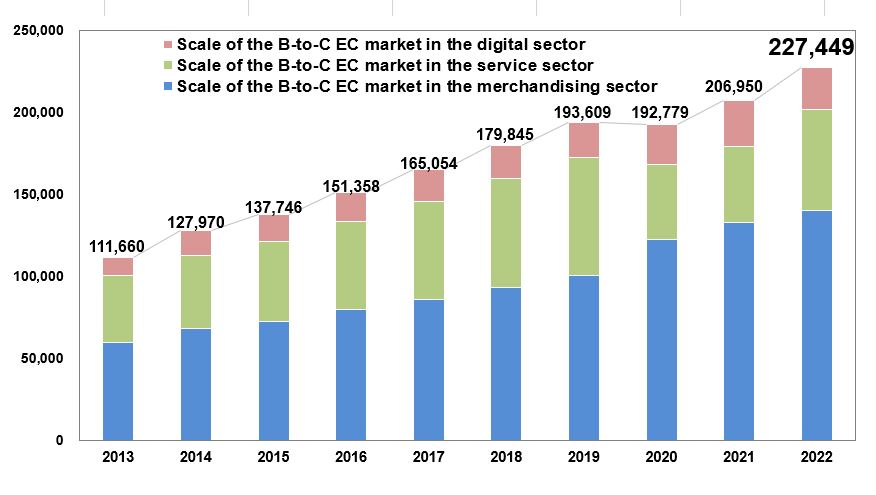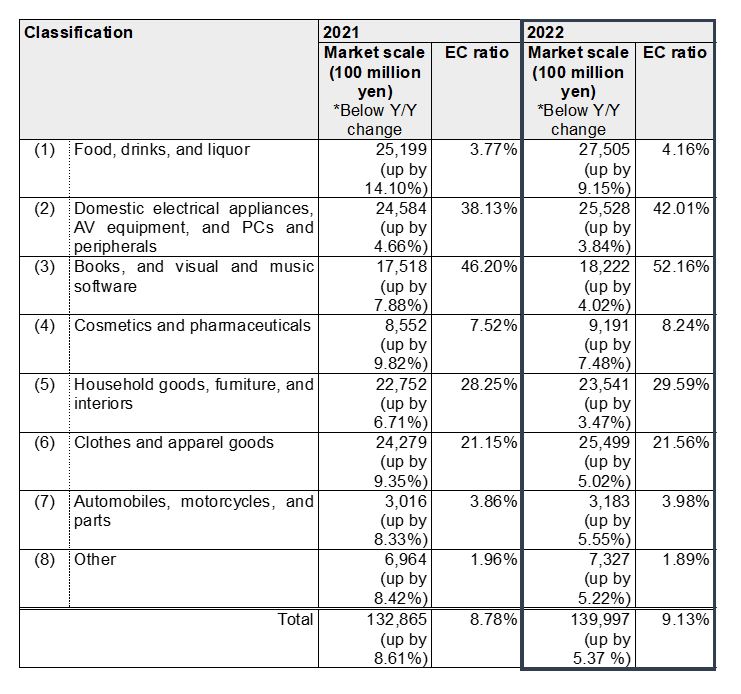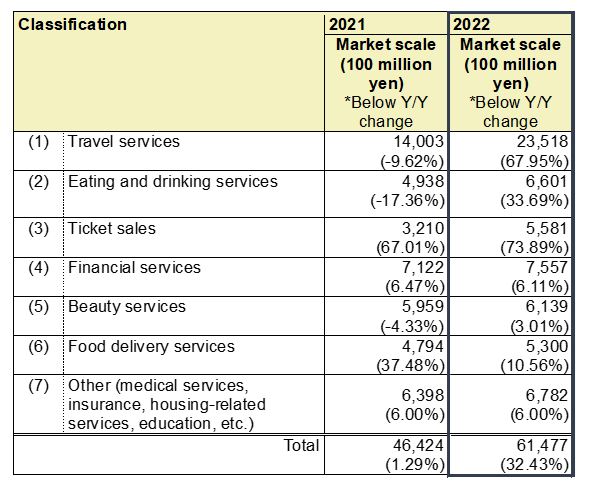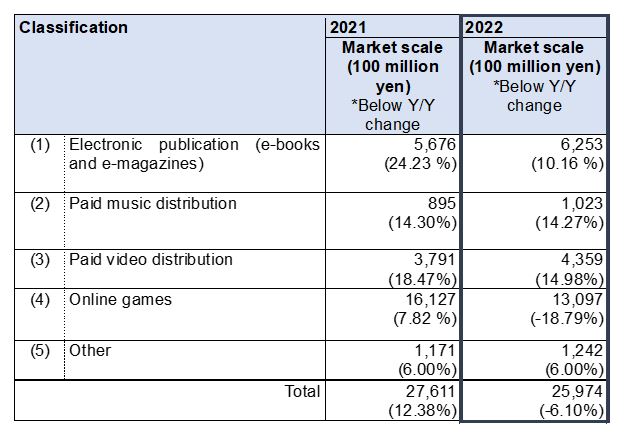- Home
- News Releases
- Back Issues
- August FY2023
- Results of FY2022 E-Commerce Market Survey Compiled
Results of FY2022 E-Commerce Market Survey Compiled
August 31, 2023
*1. “Changes in the scale of the B-to-C EC market over time” graph was corrected on October 4, 2024 due to unit error in the original.
The Ministry of Economy, Trade and Industry (METI) conducted the FY2022 E-Commerce Market Survey to analyze the current state of the Japanese e-commerce (EC) market. It has now compiled the results into a report.
1. Summary of the survey results
(1) Scale of the domestic EC market (business-to-consumer [B-to-C] and business-to-business [B-to-B])
In 2022, the scale of the domestic B-to-C EC market increased to 22.7 trillion yen (up by 9.91% from 20.7 trillion yen in the previous year, and 19.3 trillion yen in the year before). In addition, the scale of the domestic B-to-B EC market increased to 420.2 trillion yen (up by 12.8% from 372.7 trillion yen in the previous year, and 334.9 trillion yen in the year before).
The EC ratio1 was 9.13% (up by 0.35 percentage points year-over-year) for B-to-C EC and 37.5% (up by 1.9 percentage points year-over-year) for B-to-B EC, showing an increasing trend and continuous progress in the computerization of commercial transactions.

The scale of the B-to-C EC market by sector is as shown below.

A. Merchandising sector
In the merchandising sector, food, drinks, and liquor (2.7505 trillion yen), domestic electrical appliances, AV equipment, and PCs and peripherals (2.5528 trillion yen), clothes and apparel goods (2.5499 trillion yen), and household goods, furniture, and interiors (2.3541 trillion yen) account for large shares. The total of these top four categories exceeds 2 trillion yen and accounts for 73% of the merchandising sector.
The EC ratios were high for books, and visual and music software (52.16%), domestic electrical appliances, AV equipment, and PCs and peripherals (42.01%), and household goods, furniture, and interiors (29.59%).

B. Service sector
In the service sector, travel services (2.3518 trillion yen) accounted for the largest share. The market scales of travel services, eating and drinking services, and ticket sales dramatically recovered in 2022 together with an increase in demand involving outings, which had sharply dropped in the previous year due to the COVID-19 pandemic.

C. Digital sector
In the digital sector, online games (1.3097 trillion yen) accounted for the largest share. However, its market scale shrank by 18.79% year-over-year.

(2) Scale of the domestic EC market (consumer-to-consumer [C-to-C])
In recent years, the C-to-C EC market2 has been dramatically expanding as an EC channel. In light of this trend, METI has been estimating the scale of the market in Japan since the 2016 survey.
The scale of the C-to-C EC market in 2022 is estimated to be 2.3630 trillion yen (up by 6.8% from the previous year).

(3) Market scale of cross-border EC between Japan, the U.S., and China
In 2022, the market scale of cross-border EC between Japan, the U.S., and China increased in all three countries. In particular, the amount purchased through cross-border EC by Chinese consumers was 2.2569 trillion yen from Japanese business operators (up by 5.6% from the previous year) and 2.7499 trillion yen from U.S. business operators (up by 6.7% from the previous year), continuing the previous year's increasing trends.

2. Outline of the E-Commerce Market Survey
This survey has been conducted every year since FY1998 with the aim of discovering the trends in the EC market and the current situation regarding its users. This was the 25th survey.
In addition to the domestic market scale of business-to-consumer, business-to-business, and consumer-to-consumer EC, the survey has also been investigating the market trends in B-to-C cross-border EC (between Japan, the U.S., and China).
Notes
- The EC ratio in this survey refers to the ratio of the e-commerce market scale to the total amount for all commercial transactions. The EC ratios are calculated based on merchandising businesses in the case of B-to-C EC, and on the business types not in the industrial classification category "Other" in the case of B-to-B EC. See the document below for more details about the survey.
- For C-to-C transactions, the survey does not only consider ones between individuals, but also includes B-to-B and B-to-C transactions, and the value for the market scale includes these as well.
Related Material
Division in Charge
Digital Market Policy Office, Digital Economy Division, Commerce and Information Policy Bureau